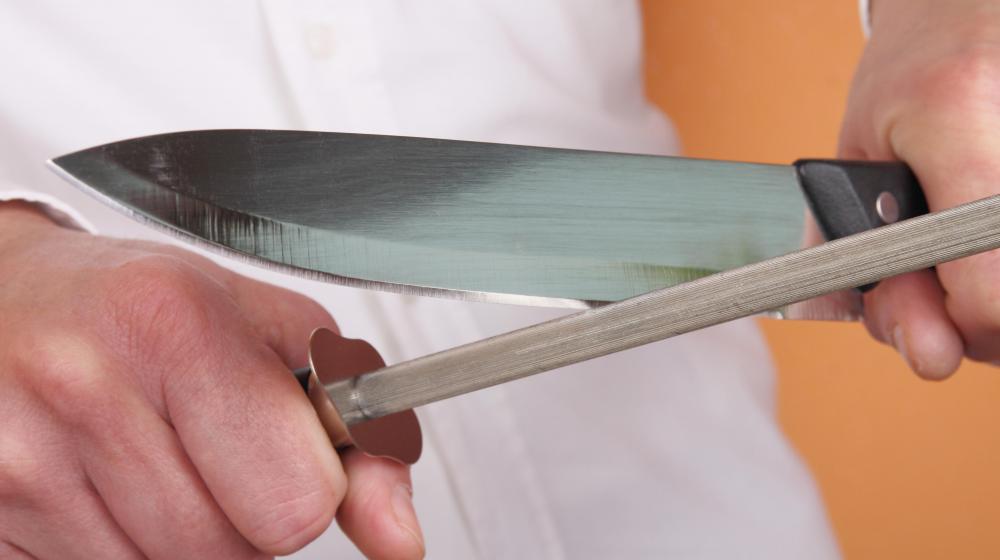At DelightedCooking, we're committed to delivering accurate, trustworthy information. Our expert-authored content is rigorously fact-checked and sourced from credible authorities. Discover how we uphold the highest standards in providing you with reliable knowledge.
What is a Chef's Knife?
A chef's knife is an all-purpose, typically long knife that is used by professional chefs and many cooks at home. It’s one of the knives that is essential to kitchen work and probably one of the better investments you can make when stocking your kitchen. In professional kitchens, the chef's knife is indispensable, and probably one of the most frequently used knives.
The average chef's knife is about 8-10 inches (20.32-25.4 cm), and its shape and features explain its usefulness in the kitchen. If you examine the knife on its side, you’ll note the widest part of it is near the handle, which is called the blade heel. When you’re slicing ingredients that are tough you’ll get the most leverage when you use the knife heel portion.

The edge of the knife curves upward, coming to a nearly fine point at the tip of the blade, and each part of the knife can be used for different purposes. The center of the chef's knife is called the cutting edge, and it’s probably used most often, for general cutting and preparation of a variety of foods. The knife tip may be used to cut small soft foods, like mushrooms or green onions.

At the handle, the blade of the knife normally has what is called a bolster. This is a small unsharpened area that should extend from the handle to the bottom of the blade. It protects the hand from coming too close to the blade while you are chopping or dicing vigorously.
Most professional chefs are concerned about what is called the tang. Some purists insist that the best knife is one where the metal of the knife extends into the handle. Some say the knife’s blade, including the tang, should be one solid piece of metal so that the knife is very durable. The handle is also is an important consideration. A few handles have grooves on the bottom to support the position of the fingers on the knife, while other chef’s knives have a straight handle.

The better the chef's knife, the more likely you’re going to pay a lot for it. Some fears exist that a really sharp knife is more hazard in the kitchen than not. Actually, you’re more likely to cut yourself with a knife that is not appropriately sharp, and when you do cut yourself with a dull knife, it tears the skin, causing a more painful cut. If you do cut yourself with a sharp chef's knife the cut is more precise, though it can still hurt, and it tends to heal more quickly.

There are a few companies that are well known for making some of the best chef’s knives. These include Henckels®, Global®, Sabatier®, and Wusthof Trident®. You’ll likely spend at least 100 US dollars (USD) on a quality chef’s knife, but the expense can be worth it. A good chef's knife can last for many years, though it will require professional sharpening from time to time.
AS FEATURED ON:
AS FEATURED ON:















Discussion Comments
@ Pelestears- My opinion is that every individual has to find the best knife for them. Every brand will have a slightly different balance, flex, width, and weight which will appeal to different people. These features will also appeal to very different cooking styles. I know people who swear nothing beats a global, while I hear others praise the weight of a henckels or wusthof knife. What one gives up in a blades ability to hold an edge is made up in the weight and balance of a knife. There are plenty of great knife manufacturers so the best option is to find a knife store that will let you handle all of the different knives to get a feel for their distinct nuances.
@ Georgesplane- My personal opinion is that you are paying more for the name of a Henckel knife than you are for the difference in quality. Everyone has heard of Henckel, and yes they are nice knives, but they are no better than some of the other knives on the market.
I personally own a custom pieced Shun knife set that I accumulated over four or five years working as a chef. The knives have better flex, better balance, and a better grip than the Henckel's including the Morimoto's. They are also only two-thirds the cost of a Morimoto. You get a better knife for a cheaper price by going with the Shun Pro or Premier.
If you are looking to really put together a knife set that lasts a lifetime, you may want to look towards the higher end Henckels knife sets. They make an excellent line of knives called Morimoto. The Morimoto chef, Utility, Santou, and Slicer would make a good foundation for a set, but be warned that these four knives can cost upwards of $1200. If you can afford the investment, you will have a set of knives that last a lifetime.
Post your comments